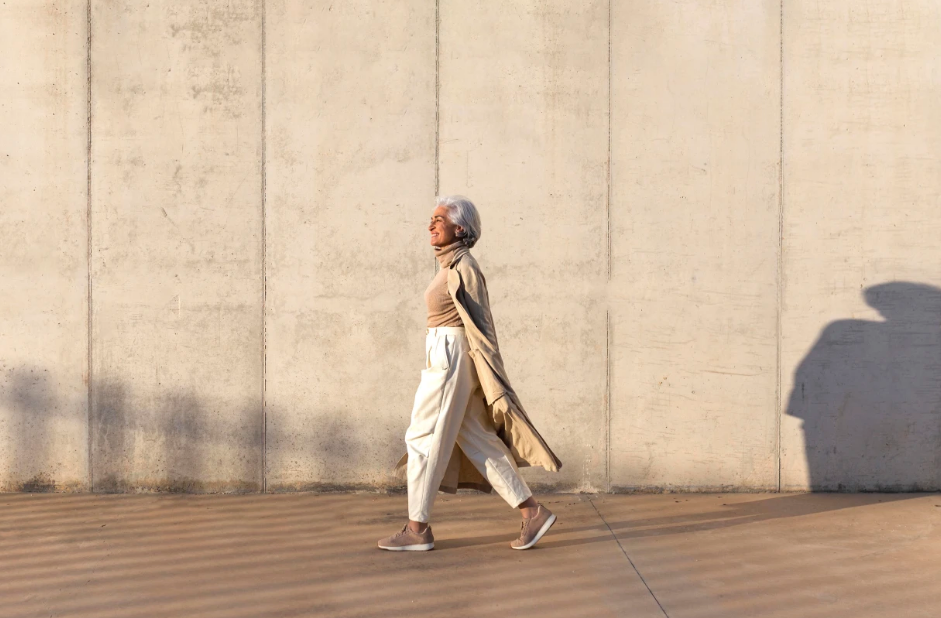What is silent walking? The latest viral workout trend has some intriguing benefits.
By: Daryl Austin
The TikTok trend of silent walking has roots in Buddhism and is a common mindfulness practice.

We’ve all heard the advice that going for a run will clear your head or that spending time outdoors can give you a fresh perspective on a problem, but a recent viral TikTok trend is marrying the two in an unexpectedly helpful way. It’s called silent walking, and it combines the health benefits of nature, exercise and meditation to center and calm its many participants. What is silent walking? Silent walking began trending earlier this summer after TikTok creator Mady Maio posted about advice she received from her nutritionist to walk for 30 minutes a day “instead of doing insane cardio like I used to.” That suggestion was followed by another from her boyfriend, who challenged her not to listen to a podcast, music, or anything else while she did so. What followed was a horde of people posting across social media about their own experiences of walking daily sans distractions. Although Maio’s video kicked off the silent walking movement’s current rise in popularity,
The concept is nothing new. “Zen Buddhist monks have long practiced silent walking under a different name which they call ‘walking meditation,’” Lalah Delia, author of the mindfulness book “Vibrate Higher Daily,” tells TODAY.com. At its core, silent walking is about clearing one’s mind and going for a walk alone, free of distractions — a practice that Buddhism teaches can transform exercise into a session of personal meditation. “Silent walking is an easy way to disconnect from all the noise and chaos that is part of our busy world,” Juanita Guerra, Ph.D., a clinical psychologist in New Rochelle, New York, tells TODAY.com. “It’s an excellent way to connect to our core selves.”
"By removing distractions, (silent walking) allows the participant to become more aware of their inner and outer environments,” psychologist Amanda Darnley, Psy.D., tells TODAY.com. Dr. Suzanne Hackenmiller, an integrative medicine physician, says that the movement is having a moment because more people are trying to reconnect with themselves. “Recent studies have found that rates of anxiety and depression have risen dramatically since the beginning of the pandemic, and I believe people are seeking natural, integrative approaches to improve their mental health,” she tells TODAY.com. How do you do a silent walk? While the idea of walking without distractions may sounds appealing, Guerra warns it’s easier said than done.
“Practicing silent walking can prove to be challenging, given that we live in an overstimulating world,” she says. To get started, the experts recommend keeping things simple: Walk in a nearby quiet area, “hopefully somewhere in nature or outdoors,” says Guerra. It’s also best to pick a time when you know there will be minimal people or activity around that area to distract you. Take care of basic bodily needs, such as thirst and hunger, beforehand, “so they don’t become a distraction,” offers Guerra. Make sure it’s just you and your thoughts. “No phone, no walking buddy, no dog,” says Guerra. Focus on your feelings, breathing and the surrounding beauty. “Be mindful of each breath and each step, listen to the sounds of nature around you, feel gratitude for the sun kissing your skin, and use the time for reflection,” advises Delia. If you're not able to walk far or don't have access to nature, know that “you can do a silent walk anywhere,” Darnley says. “For those of us who live in cities, you can still engage in a silent walk — your environment doesn’t necessarily need to be silent, but you do.” Hackenmiller adds that people with mobility issues who wish to experience the benefits of silent walking can do so by finding a reflective “sit spot” outside, “where you sit quietly in nature for at least twenty minutes, simply noticing what you notice.”
What are the benefits of silent walking? The health benefits of silent walking include reducing stress, increased energy and resilience, and a deeper connection to oneself, as well as lower blood pressure and heart rate. Recommended
